Page 316 of 409
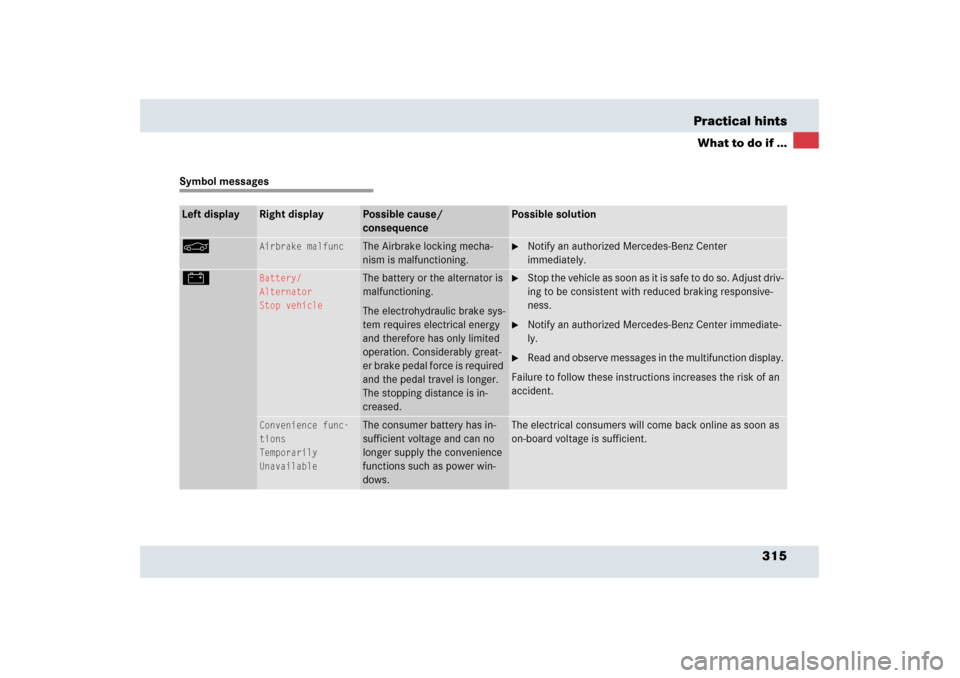
315 Practical hints
What to do if ...
Symbol messagesLeft display
Right display
Possible cause/
consequence
Possible solution
<
Airbrake malfunc
The Airbrake locking mecha-
nism is malfunctioning.
�
Notify an authorized Mercedes-Benz Center
immediately.
#
Battery/
Alternator
Stop vehicle
The battery or the alternator is
malfunctioning.
The electrohydraulic brake sys-
tem requires electrical energy
and therefore has only limited
operation. Considerably great-
er brake pedal force is required
and the pedal travel is longer.
The stopping distance is in-
creased.
�
Stop the vehicle as soon as it is safe to do so. Adjust driv-
ing to be consistent with reduced braking responsive-
ness.
�
Notify an authorized Mercedes-Benz Center immediate-
ly.
�
Read and observe messages in the multifunction display.
Failure to follow these instructions increases the risk of an
accident.
Convenience func-
tions
Temporarily
Unavailable
The consumer battery has in-
sufficient voltage and can no
longer supply the convenience
functions such as power win-
dows.
The electrical consumers will come back online as soon as
on-board voltage is sufficient.
Page 317 of 409

316 Practical hintsWhat to do if ...Left display
Right display
Possible cause/
consequence
Possible solution
#
Visit
workshop
The battery is no longer charg-
ing. Possible causes:�
alternator malfunctioning
�
broken poly-V-belt
Do not forget that the brake
system requires electrical ener-
gy and may be operating with
restricted capability. Consider-
ably greater brake pedal force
is required and the pedal travel
is longer. The stopping distance
is increased.
�
Stop your vehicle immediately in a safe location and
check the poly-V-belt.
If it is broken:�
Do not continue to drive. Otherwise the engine will
overheat due to an inoperative water pump which
may result in damage to the engine. Notify an
authorized Mercedes-Benz Center.
If it is in order:
�
Drive immediately to the nearest authorized
Mercedes-Benz Center. Adjust driving to be consis-
tent with reduced braking responsiveness.
�
Read and observe messages in the multifunction display.
There is a malfunction in the
electronic system.
�
Have the system checked at an authorized
Mercedes-Benz Center immediately.
Page 321 of 409
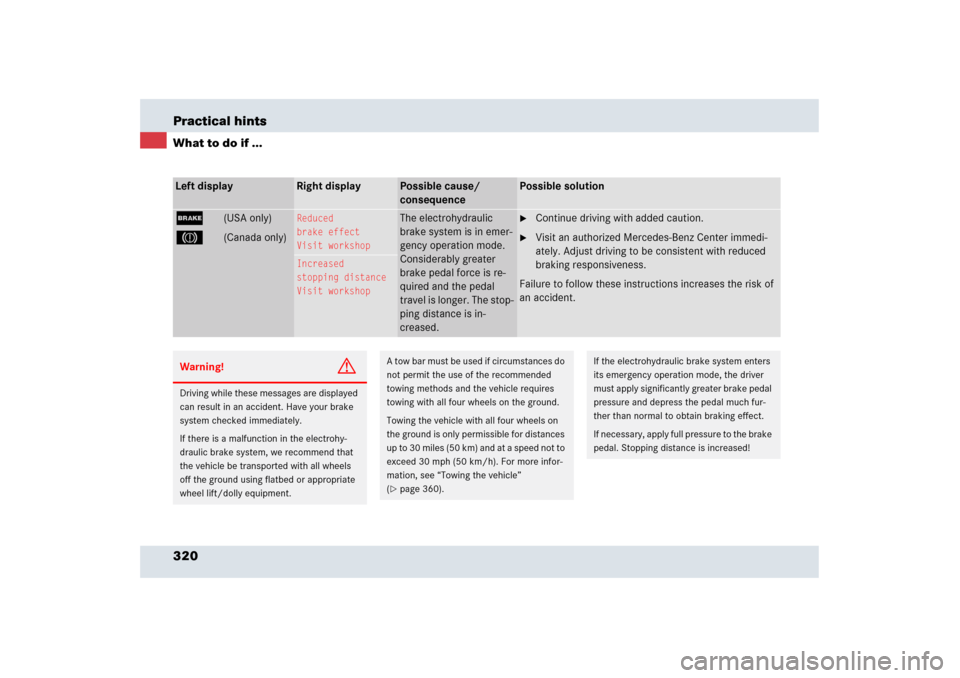
320 Practical hintsWhat to do if ...Left display
Right display
Possible cause/
consequence
Possible solution
;
(USA only)
3
(Canada only)
Reduced
brake effect
Visit workshop
The electrohydraulic
brake system is in emer-
gency operation mode.
Considerably greater
brake pedal force is re-
quired and the pedal
travel is longer. The stop-
ping distance is in-
creased.
�
Continue driving with added caution.
�
Visit an authorized Mercedes-Benz Center immedi-
ately. Adjust driving to be consistent with reduced
braking responsiveness.
Failure to follow these instructions increases the risk of
an accident.
Increased
stopping distance
Visit workshop
Warning!
G
Driving while these messages are displayed
can result in an accident. Have your brake
system checked immediately.
If there is a malfunction in the electrohy-
draulic brake system, we recommend that
the vehicle be transported with all wheels
off the ground using flatbed or appropriate
wheel lift/dolly equipment.
A tow bar must be used if circumstances do
not permit the use of the recommended
towing methods and the vehicle requires
towing with all four wheels on the ground.
Towing the vehicle with all four wheels on
the ground is only permissible for distances
up to 30 miles (50 km) and at a speed not to
exceed 30 mph (50 km/h). For more infor-
mation, see “Towing the vehicle”
(�page 360).
If the electrohydraulic brake system enters
its emergency operation mode, the driver
must apply significantly greater brake pedal
pressure and depress the pedal much fur-
ther than normal to obtain braking effect.
If necessary, apply full pressure to the brake
pedal. Stopping distance is increased!
Page 336 of 409
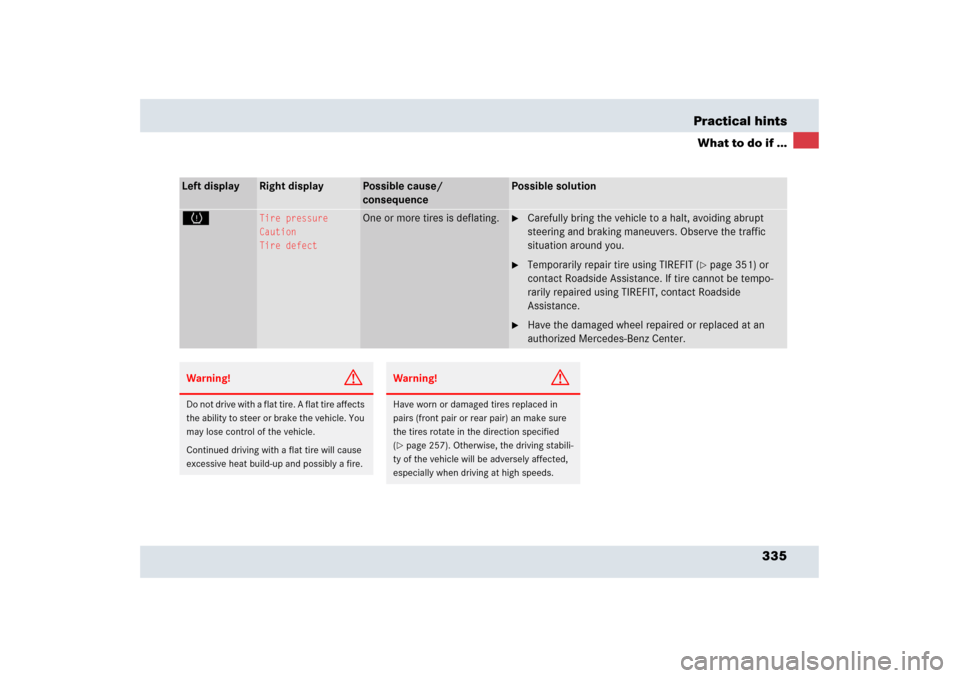
335 Practical hints
What to do if ...
Left display
Right display
Possible cause/
consequence
Possible solution
H
Tire pressure
Caution
Tire defect
One or more tires is deflating.
�
Carefully bring the vehicle to a halt, avoiding abrupt
steering and braking maneuvers. Observe the traffic
situation around you.
�
Temporarily repair tire using TIREFIT (
�page 351) or
contact Roadside Assistance. If tire cannot be tempo-
rarily repaired using TIREFIT, contact Roadside
Assistance.
�
Have the damaged wheel repaired or replaced at an
authorized Mercedes-Benz Center.
Warning!
G
Do not drive with a flat tire. A flat tire affects
the ability to steer or brake the vehicle. You
may lose control of the vehicle.
Continued driving with a flat tire will cause
excessive heat build-up and possibly a fire.
Warning!
G
Have worn or damaged tires replaced in
pairs (front pair or rear pair) an make sure
the tires rotate in the direction specified
(�page 257). Otherwise, the driving stabili-
ty of the vehicle will be adversely affected,
especially when driving at high speeds.
Page 337 of 409
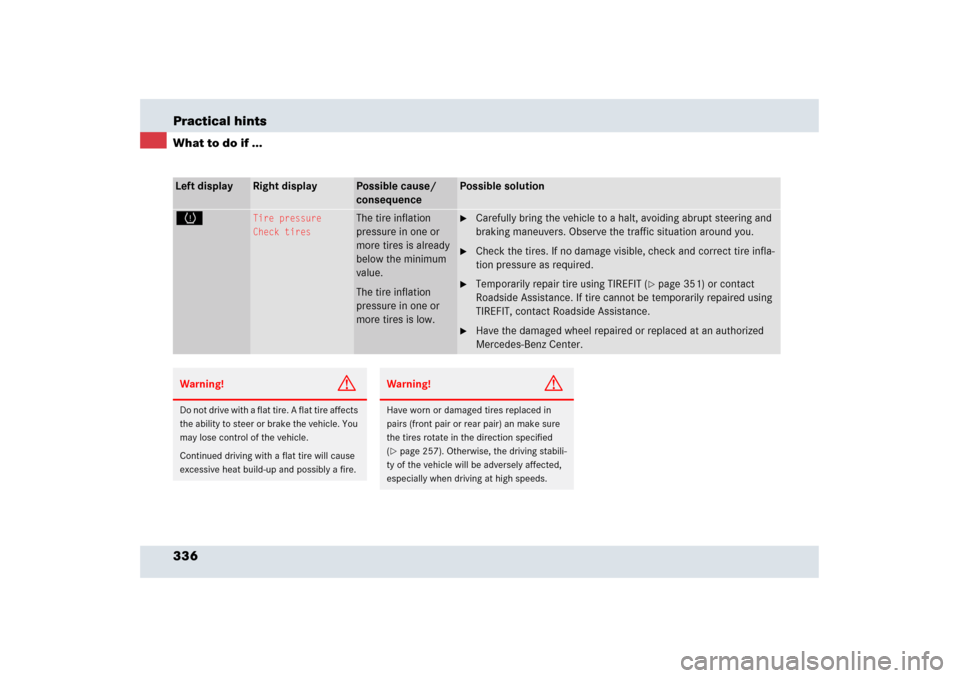
336 Practical hintsWhat to do if ...Left display
Right display
Possible cause/
consequence
Possible solution
H
Tire pressure
Check tires
The tire inflation
pressure in one or
more tires is already
below the minimum
value.
The tire inflation
pressure in one or
more tires is low.
�
Carefully bring the vehicle to a halt, avoiding abrupt steering and
braking maneuvers. Observe the traffic situation around you.
�
Check the tires. If no damage visible, check and correct tire infla-
tion pressure as required.
�
Temporarily repair tire using TIREFIT (
�page 351) or contact
Roadside Assistance. If tire cannot be temporarily repaired using
TIREFIT, contact Roadside Assistance.
�
Have the damaged wheel repaired or replaced at an authorized
Mercedes-Benz Center.
Warning!
G
Do not drive with a flat tire. A flat tire affects
the ability to steer or brake the vehicle. You
may lose control of the vehicle.
Continued driving with a flat tire will cause
excessive heat build-up and possibly a fire.
Warning!
G
Have worn or damaged tires replaced in
pairs (front pair or rear pair) an make sure
the tires rotate in the direction specified
(�page 257). Otherwise, the driving stabili-
ty of the vehicle will be adversely affected,
especially when driving at high speeds.
Page 338 of 409

337 Practical hints
What to do if ...
Left display
Right display
Possible cause/
consequence
Possible solution
H
Tire pressure, FL
Caution
Tire defect
The left front tire is
deflating.
�
Carefully bring the vehicle to a halt, avoiding abrupt steering and
braking maneuvers. Observe the traffic situation around you.
�
Temporarily repair tire using TIREFIT (
�page 351) or contact
Roadside Assistance. If tire cannot be temporarily repaired using
TIREFIT, contact Roadside Assistance.
�
Have the damaged wheel repaired or replaced at an authorized
Mercedes-Benz Center.
Tire pressure, FL
Check
tires
The left front tire in-
flation pressure is
low.
�
Carefully bring the vehicle to a halt.
�
Check the tires. If no damage visible, check and correct tire infla-
tion pressure as required.
�
If necessary, have the wheel repaired or replaced at an authorized
Mercedes-Benz Center.
Warning!
G
Do not drive with a flat tire. A flat tire affects
the ability to steer or brake the vehicle. You
may lose control of the vehicle.
Continued driving with a flat tire will cause
excessive heat build-up and possibly a fire.
Warning!
G
Have worn or damaged tires replaced in
pairs (front pair or rear pair) an make sure
the tires rotate in the direction specified
(�page 257).
Otherwise, the driving stability of the vehicle
will be adversely affected, especially when
driving at high speeds.
Page 339 of 409
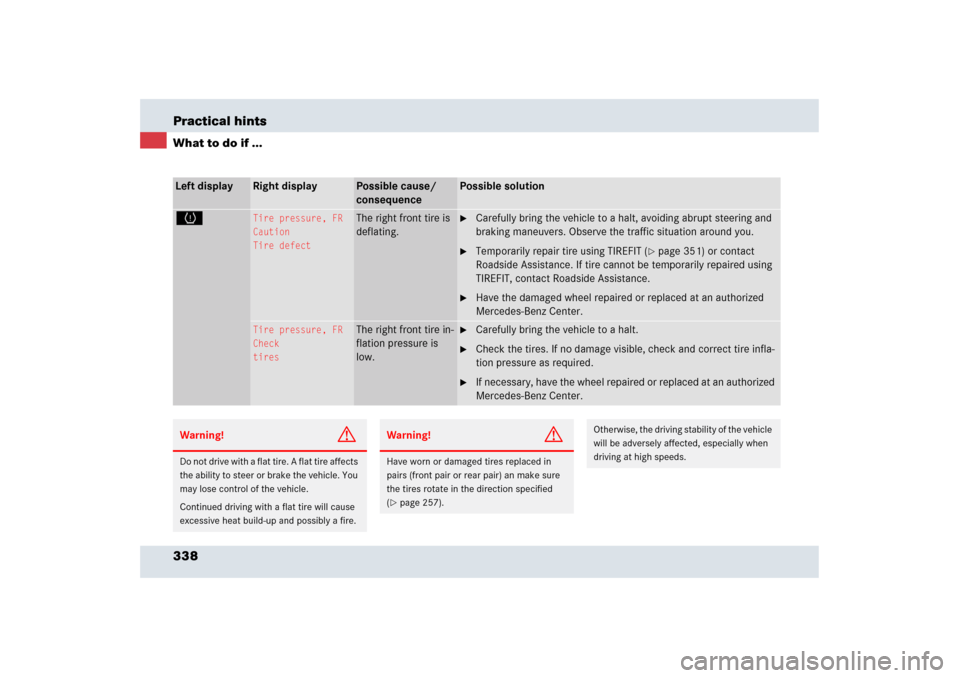
338 Practical hintsWhat to do if ...Left display
Right display
Possible cause/
consequence
Possible solution
H
Tire pressure, FR
Caution
Tire defect
The right front tire is
deflating.
�
Carefully bring the vehicle to a halt, avoiding abrupt steering and
braking maneuvers. Observe the traffic situation around you.
�
Temporarily repair tire using TIREFIT (
�page 351) or contact
Roadside Assistance. If tire cannot be temporarily repaired using
TIREFIT, contact Roadside Assistance.
�
Have the damaged wheel repaired or replaced at an authorized
Mercedes-Benz Center.
Tire pressure, FR
Check
tires
The right front tire in-
flation pressure is
low.
�
Carefully bring the vehicle to a halt.
�
Check the tires. If no damage visible, check and correct tire infla-
tion pressure as required.
�
If necessary, have the wheel repaired or replaced at an authorized
Mercedes-Benz Center.
Warning!
G
Do not drive with a flat tire. A flat tire affects
the ability to steer or brake the vehicle. You
may lose control of the vehicle.
Continued driving with a flat tire will cause
excessive heat build-up and possibly a fire.
Warning!
G
Have worn or damaged tires replaced in
pairs (front pair or rear pair) an make sure
the tires rotate in the direction specified
(�page 257).
Otherwise, the driving stability of the vehicle
will be adversely affected, especially when
driving at high speeds.
Page 340 of 409
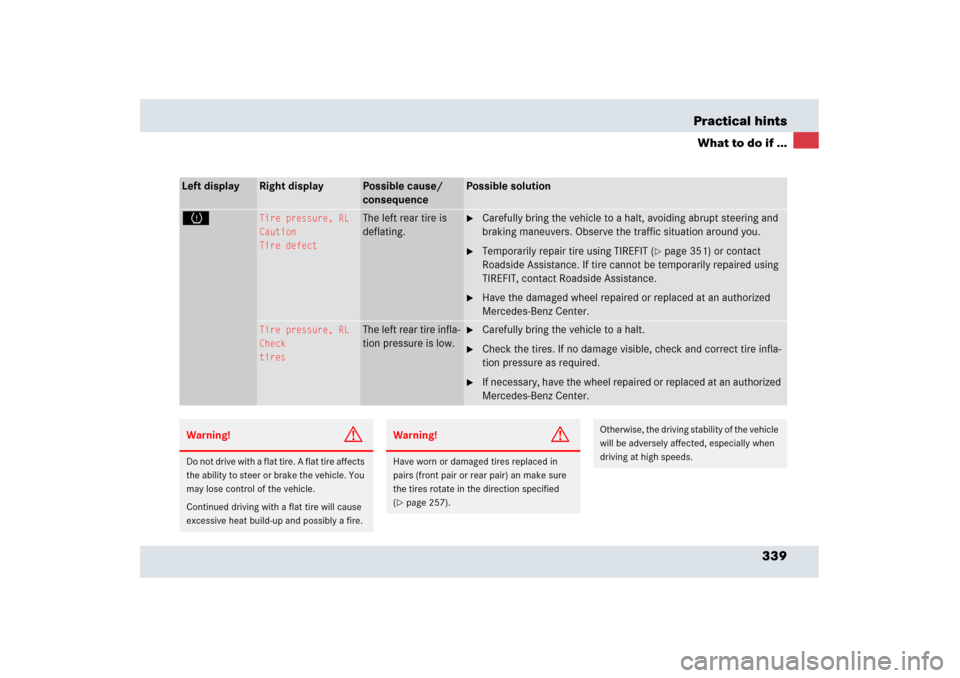
339 Practical hints
What to do if ...
Left display
Right display
Possible cause/
consequence
Possible solution
H
Tire pressure, RL
Caution
Tire defect
The left rear tire is
deflating.
�
Carefully bring the vehicle to a halt, avoiding abrupt steering and
braking maneuvers. Observe the traffic situation around you.
�
Temporarily repair tire using TIREFIT (
�page 351) or contact
Roadside Assistance. If tire cannot be temporarily repaired using
TIREFIT, contact Roadside Assistance.
�
Have the damaged wheel repaired or replaced at an authorized
Mercedes-Benz Center.
Tire pressure, RL
Check
tires
The left rear tire infla-
tion pressure is low.
�
Carefully bring the vehicle to a halt.
�
Check the tires. If no damage visible, check and correct tire infla-
tion pressure as required.
�
If necessary, have the wheel repaired or replaced at an authorized
Mercedes-Benz Center.
Warning!
G
Do not drive with a flat tire. A flat tire affects
the ability to steer or brake the vehicle. You
may lose control of the vehicle.
Continued driving with a flat tire will cause
excessive heat build-up and possibly a fire.
Warning!
G
Have worn or damaged tires replaced in
pairs (front pair or rear pair) an make sure
the tires rotate in the direction specified
(�page 257).
Otherwise, the driving stability of the vehicle
will be adversely affected, especially when
driving at high speeds.